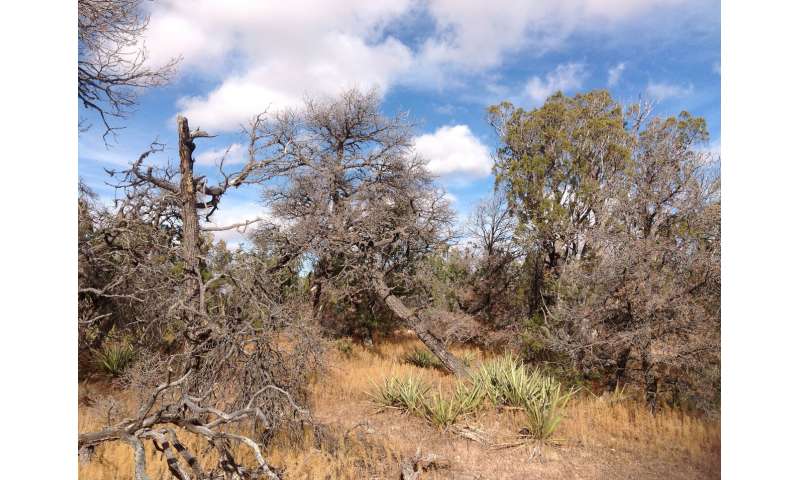by Bob Yirka , Phys.org

Drought-related mortality of Cedrus atlántica and its replacement by Quercus rotundifolia, Middle Atlas, Morocco. Credit: Enric Batllori
A large international team of researchers has found that forested areas that experience tree loss due to drought have a wide range of regrowth possibilities after the drought ends. In their paper published in Proceedings of the National Academy of Sciences, the group describes their study of forested areas around the globe that experienced drought and what happened to them when it was over.
As global warming continues seemingly unabated, scientists are attempting to predict what increased temperatures might do to the planet. Current models suggest rainfall will shift, with some areas receiving more rain and others less. They also show that many areas will likely experience both long- and short-duration droughts. In this new effort, the researchers wondered what might happen to drought-afflicted forested areas when a drought ends.
Prior research has shown that extended droughts can lead to widespread tree death in forested areas. Prior research has also shown that in some instances, the trees will grow back after the drought is over but in other situations, trees do not grow back; instead, they are replaced by shrubs and other plants. In this new effort, the researchers took a fresh look at forest regrowth after drought by analyzing data describing the impact of drought on forested areas from 131 sites across the globe and then compared what they found to see if any patterns emerged.
In comparing the data, the researchers found that only 21 percent of the forests grew back into their prior state. They also found that 10% of them shifted to non-forested plant growth, from shrubbery to grasslands. In those sites where the trees did not grow back, two-thirds of them were taken over by shrubs and 10% were taken over by non-wood-type vegetation.

A large international team of researchers has found that forested areas that experience tree loss due to drought have a wide range of regrowth possibilities after the drought ends. In their paper published in Proceedings of the National Academy of Sciences, the group describes their study of forested areas around the globe that experienced drought and what happened to them when it was over.
As global warming continues seemingly unabated, scientists are attempting to predict what increased temperatures might do to the planet. Current models suggest rainfall will shift, with some areas receiving more rain and others less. They also show that many areas will likely experience both long- and short-duration droughts. In this new effort, the researchers wondered what might happen to drought-afflicted forested areas when a drought ends.
Prior research has shown that extended droughts can lead to widespread tree death in forested areas. Prior research has also shown that in some instances, the trees will grow back after the drought is over but in other situations, trees do not grow back; instead, they are replaced by shrubs and other plants. In this new effort, the researchers took a fresh look at forest regrowth after drought by analyzing data describing the impact of drought on forested areas from 131 sites across the globe and then compared what they found to see if any patterns emerged.
In comparing the data, the researchers found that only 21 percent of the forests grew back into their prior state. They also found that 10% of them shifted to non-forested plant growth, from shrubbery to grasslands. In those sites where the trees did not grow back, two-thirds of them were taken over by shrubs and 10% were taken over by non-wood-type vegetation.

Lack of replacement by woody vegetation after drought-related mortality in Pinus edulis forests, New Mexico, USA. Credit: Francisco Lloret
The researchers also found that areas that experienced average or greater amounts of rainfall after the drought ended were more likely to return to tree cover. In other areas where there was less rainfall, there were many instances of trees of one type being replaced by another that needed less water to survive. They also found that in areas where pests infected trees during times of drought, contributing to tree death, the area was much less likely to return to its forested state. The researchers also found other factors contributed to growth after a drought, such as community composition, human management and shade tolerance. They conclude by suggesting the variety of changes likely means that it may not be possible to predict what might occur in forested areas as future droughts become longer and more frequent.
Explore further Small trees offer hope for rainforests
The researchers also found that areas that experienced average or greater amounts of rainfall after the drought ended were more likely to return to tree cover. In other areas where there was less rainfall, there were many instances of trees of one type being replaced by another that needed less water to survive. They also found that in areas where pests infected trees during times of drought, contributing to tree death, the area was much less likely to return to its forested state. The researchers also found other factors contributed to growth after a drought, such as community composition, human management and shade tolerance. They conclude by suggesting the variety of changes likely means that it may not be possible to predict what might occur in forested areas as future droughts become longer and more frequent.
Explore further Small trees offer hope for rainforests
More information: Enric Batllori et al. Forest and woodland replacement patterns following drought-related mortality, Proceedings of the National Academy of Sciences (2020). DOI: 10.1073/pnas.2002314117
Journal information: Proceedings of the National Academy of Sciences
© 2020 Science X Network
No comments:
Post a Comment